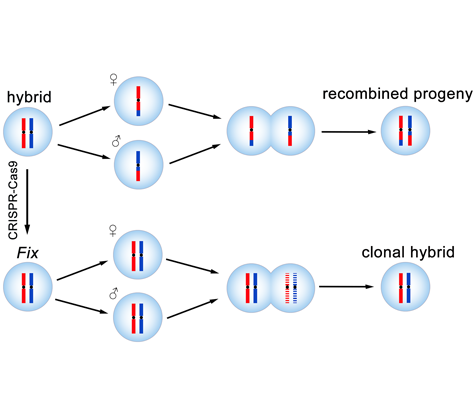中国科学家在杂种F1克隆繁殖研究领域取得突破性进展
Chinese Scientists Make Groundbreaking Discoveries in Clonal Propagation of F1 Hybrids
- Key Laboratory of Plant Molecular Physiology, Institute of Botany, Chinese Academy of Sciences, Beijing 100093, China
Received date: 2019-01-09
Accepted date: 2019-01-10
Online published: 2019-01-15
摘要
本文引用格式
薛治慧 , 种康 . 中国科学家在杂种F1克隆繁殖研究领域取得突破性进展[J]. 植物学报, 2019 , 54(1) : 1 -3 . DOI: 10.11983/CBB19004
Abstract
Heterosis has been widely applied to improve the productivity and adaptability of crops. However, progeny of hybrid exhibits segregation, hybrid seed need to be produced using male sterile and restorer lines each year. Hybrid seed production is prohibitively expensive and the purity of hybrid seed is uncertain, that limit the extension of its large adoption. Recently, Chinese scientists obtained clonal F1 seeds from hybrid rice by genome editing of some meiosis and fertilization related genes. Their work shed light on utilization and fixation of the heterosis by ‘one line’ method.

参考文献
| 1 | Barcaccia G, Albertini E ( 2013). Apomixis in plant repro- duction: a novel perspective on an old dilemma. Plant Rep 26, 159-179. |
| 2 | Gilles LM, Khaled A, Laffaire JB, Chaignon S, Gendrot G, Laplaige J, Berges H, Beydon G, Bayle V, Barret P, Comadran J, Martinant JP, Rogowsky PM, Widiez T ( 2017). Loss of pollen-specific phospholipase NOT LIKE DAD triggers gynogenesis in maize. EMBO J 36, 707-717. |
| 3 | Kelliher T, Starr D, Richbourg L, Chintamanani S, Delzer B, Nuccio ML, Green J, Chen Z, McCuiston J, Wang W, Liebler T, Bullock P, Martin B ( 2017). MATRILINEAL, a sperm-specific phospholipase, triggers maize haploid in- duction. Nature 542, 105-109. |
| 4 | Koltunow AM, Grossniklaus U ( 2003). Apomixis: a develop-mental perspective.Ann Rev Plant Biol 54, 547-574. |
| 5 | Liu C, Li X, Meng D, Zhong Y, Chen C, Dong X, Xu X, Chen B, Li W, Li L, Tian X, Zhao H, Song W, Luo H, Zhang Q, Lai J, Jin W, Yan J, Chen S ( 2017). A 4 bp insertion at ZmPLA1 encoding a putative phospholipase A generates haploid induction in maize. Mol Plant 10, 520-522. |
| 6 | Marimuthu MP, Jolivet S, Ravi M, Pereira L, Davda JN, Cromer L, Wang L, Nogue F, Chan SW, Siddiqi I, Mercier R ( 2011). Synthetic clonal reproduction through seeds. Science 331, 876. |
| 7 | Mieulet D, Jolivet S, Rivard M, Cromer L, Vernet A, Mayonove P, Pereira L, Droc G, Courtois B, Guider-doni E, Mercier R , (2016). Turning rice meiosis into mitosis. Cell Res 26, 1242-1254. |
| 8 | Ozias-Akins P, van Dijk PJ ( 2007). Mendelian genetics of apomixis in plants. Ann Rev Genet 41, 509-537. |
| 9 | Spillane C, Curtis MD, Grossniklaus U ( 2004). Apomixis technology development-virgin births in farmers' fields? Nat Biotechnol 22, 687-691. |
| 10 | Wang C, Liu Q, Shen Y, Hua Y, Wang J, Lin J, Wu M, Sun T, Cheng Z, Mercier R, Wang K (2019). Clonal seeds from hybrid rice by simultaneous genome engineering of meiosis and fertilization genes. Nat Biotechnoldoi: . |
| 11 | Yao L, Zhang Y, Liu C, Liu Y, Wang Y, Liang D, Liu J, Sahoo G, Kelliher T ( 2018). OsMATL mutation induces haploid seed formation in indica rice.Nat Plants 4, 530-533. |
| 12 | Yuan l ( 2018). The strategy for hybrid rice development. Hybrid Rice 33, 1-2. |